welp, the other shoe dropped.
Here's your big nosey update and what the plan is.
I tripped and fell into a puddle of new information about my body last week and I’ll be really honest upfront here: it’s not great news. It feels silly to write this on Substack, but it’s much easier for me to summarize once and share with everyone than it is to try and have this conversation repeatedly. Plus, it’s easy to add graphics here. It’s long, but of course it is. Chronic illness is not exactly simple.
tl;dr (aka summary) located at the bottom for those who prefer that.
For those just joining the program, here’s the brief timeline of my illness:
2006: virus made me sick
2007: mostly recovered
2008-2016: gradual increase in symptoms, doctors not helpful
2017: chronic fatigue (ME/CFS) diagnosis
2018: stopped working entirely
2019: applied for disability
2022: awarded disability
2022: got wheelchair
Getting disability approved was a big deal because my illness is difficult to prove. The symptoms are vague: fatigue and pain. It’s not lost on me that I appear very normal, even looking healthy to most people. There is very little medical research to provide guidance on diagnosis and treatment options. You’ll have to trust me on this but one of the biggest studies ever done on ME/CFS had ethical issues on the scale of “vaccines cause autism. They found that “ME/CFS patients need to see a therapist and increase their exercise gradually.” I still get that advice in 2024 from doctors despite it having been thoroughly debunked.
My disability case was difficult to win. Every lawyer refused to take it, citing my age and lack of “definitive” medical proof. Then I found Vance Jennings who crushed it. You can and should call him if you are considering applying yourself. He’s the man. He won my case.
I forked over $1800 for testing (with insurance), hoping it would pay off with the proof we needed to win our appeal. Although I had an army of medical professionals who could vouch for my level of disability, there was no way around the fact that Social Security reviewers might deny me for just being tired with normal medical tests.
Enter: the cardiopulmonary exercise test. My former partner took me to the appointment. The doctor hooked me up to an exercise bike, put sticky things on my chest, a clippy thing on my finger, a squeezy thing on my arm, and a mask to measure all of the air that was coming out of my mouth holes. As the printer spit out the results, the doctor remarked, “oh this is going to be really helpful evidence.” He showed me the data, and I sobbed. My partner tried to comfort me and was very confused when I told them: these are tears of joy. I was thrilled to see what I was feeling on paper. But the news itself was pretty bad. Here are a few excerpts from the 2022 report:
“Based on the maximal aerobic work capacity of 15.0 ml/min/kg, this patient is severely incapacitated and unable to work. This is considered a 75% whole person impairment according to AMA Guidelines. These findings are consistent individuals with Class C cardiac failure as defined by Weber et al. Exerting for more than 36 seconds, exceeding a heart rate of 158 bpm, or exceeding 1.66 METS risks a flare or relapse. Since one requires 1.9 METS just to sit and write, and 2.54 METS to perform sedentary desk work, this individual would be unable to perform even sedentary work on a regular or sustained basis. The drop in core temperature with maximum exertion is unusual and reflects an abnormal neuroendocrine response.”
No wonder I like to be reclined so much! My body could barely produce enough energy to sit. My core temperature dropped when I exerted myself more? Ridiculous. I had a full cardiac workup (normal and healthy), a sleep study (very mild apnea so got a CPAP), and tilt table test (not normal but not too bad). And I got myself set up with a *reclining* wheelchair, and limited my activities even more. It worked.
Until now. Insert shoe dropping here.
I’ve worn a Fitbit since about 2015, when I was running and taking step aerobic classes at the YMCA. At some point, it became more of a tool for pacing myself, not a tool for measuring fitness. I jokingly referred to it as my “unfitbit.”
Remember when I was stressed out about cleaning my garage a few weeks ago? The boys and I tackled that with some major teamwork energy on October 5. It was so hard on me physically. Curious to see the “damage,” I checked my Fitbit but it didn’t capture data. I hadn’t paired it properly with my new phone yet. I was crushed, unreasonably so.
And what do we do when we have unreasonable feelings about missing data?
AN EMOTIONAL SUPPORT SPREADSHEET, obviously.
I realized it had been a long time since I tried to extrapolate patterns from the data. I didn’t have insight into garage cleaning day but with years of data, surely I could discover *something.*
I expected a pretty direct correlation between steps I take each day and my “active zone minutes” number. Without getting too bogged down in Fitbit’s proprietary system of doing this: it’s a measure of how much time my heart is spending at higher thresholds. Based on that fancy $1800 test, I need to keep my HR under 106. So “active zone minutes” are the minutes my HR is above 106. This correlation between steps and zone minutes was not found.
For example, on 10/2/23, my sister and I were in Syracuse and had gone to my aunt’s funeral the day before. We explored our childhood small town, drove about 3-4 hours during that day, and the boys and I flew home to Raleigh from Syracuse. I had 107 zone minutes and took 6545 steps. Three days later on 10/5/23, I was resting in bed and had 145 zone minutes and took 2934 steps.
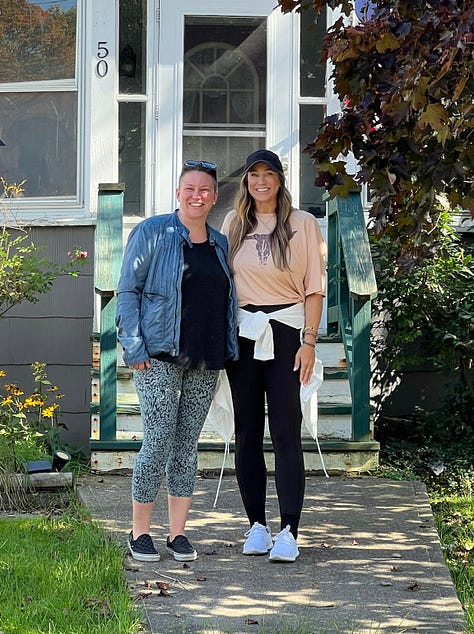

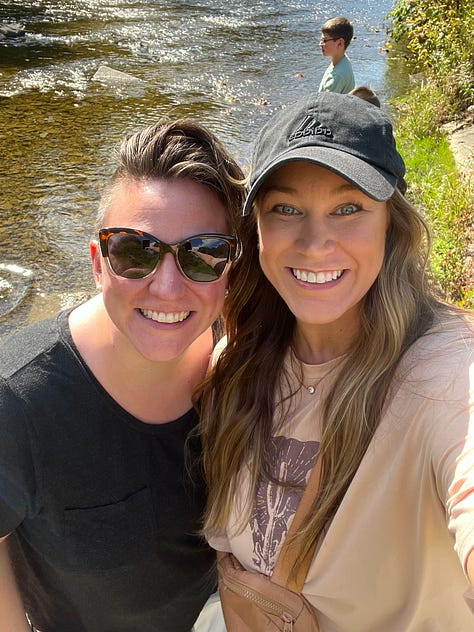
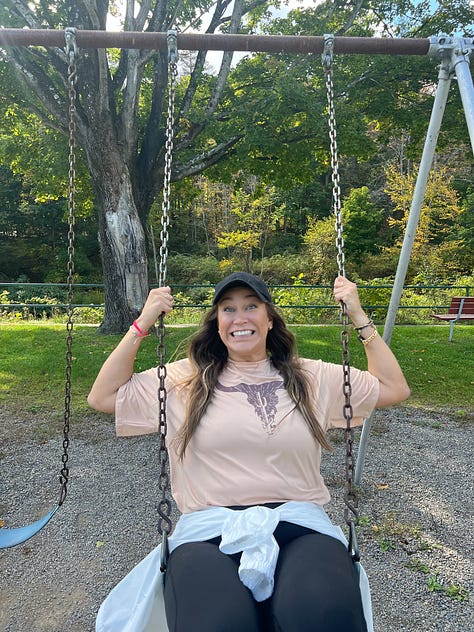
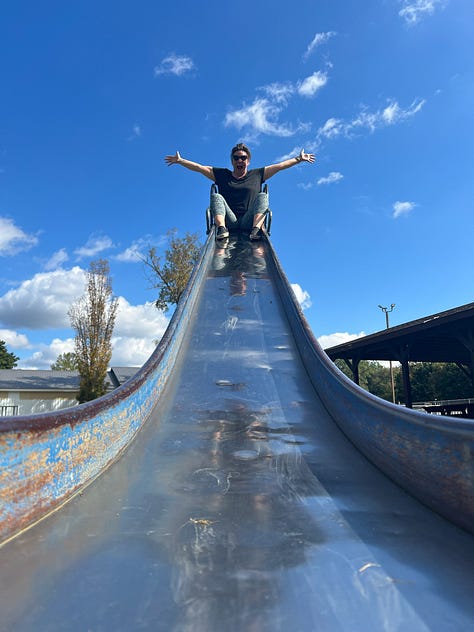
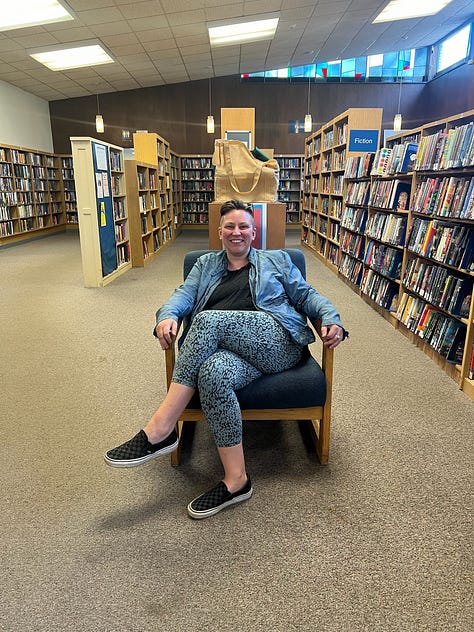
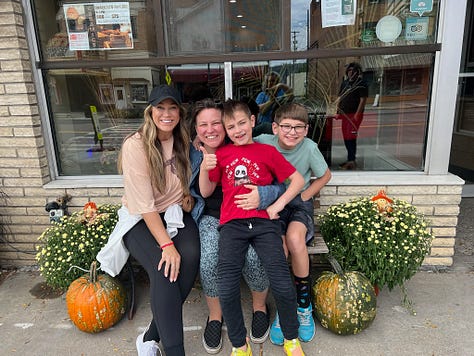
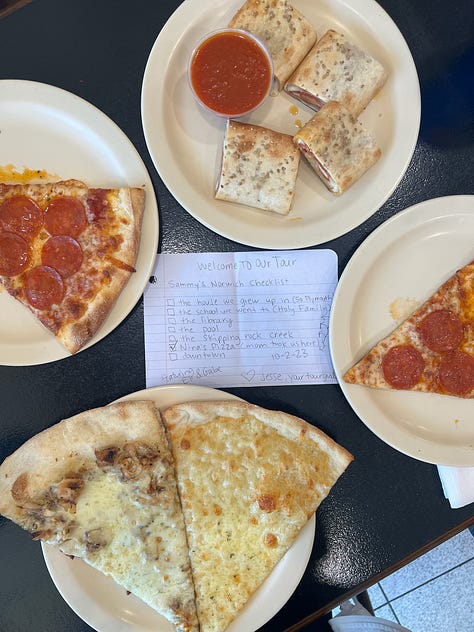

This, dear reader, is the definition of “post exertional malaise,” which is a hallmark symptom of ME/CFS. There are many more examples like that. I knew this but seeing the EMOTIONAL SUPPORT SPREADSHEET spell it out was so helpful.
I also discovered that on average, I have about 50 active zone minutes per day over the last year. That seemed high to me, but I genuinely didn’t know. I texted my sister-in-law who I knew had a Fitbit and she said, “I don’t get any active zone minutes unless I’m walking briskly.” Oh. Ok. It begged the question, what is normal?
And what do we do when we aren’t sure what normal is?
WE LOOK FOR A CONTROL GROUP, obviously.
About a dozen friends who wear their Fitbits daily responded to my Facebook post asking for info. It turns out, across the board, no one else’s heart rate is doing what mine is doing. Theirs are all behaving normally: active minutes correlate with intentional effort to exercise or physically active jobs like “janitorial work at a fitness center.”
Our resting heart rates all hovered around the same 70ish, plus or minus maybe 10. Our heart rate zones were comparable, though not exact. Mine is 106-158. Other people were 102-157+, 107-145+, 116-166+, 111-159+, 113-158+, 110-164+. Basically the same. Same enough to not stress about either of those variables.
My friends are getting 31, 51, 15, 45, 25, and 40 active zone minutes per day. Those numbers match up with the amount of time they say they are exercising. This isn’t just averages for a day, it’s 8 months worth of data of “normal” people. Here is my data compared to a woman about my age who says she exercises 1 hour and 20 minutes approximately 3-4 times per week:
Those are…not the same. What the hell is going on with my cardiovascular system? How am I do that much exercise without moving that much? I’m not able to produce the energy necessary to allow my body to function. While scientists don’t know why yet, they do know it’s real. This is how CFS/ME works. That’s the illness right there in the graphs.
After a few days of digesting the fact that my body appears to be really struggling, I talked to my boys. I mentioned what my stats looked like on Thursday. Thursday is one of my two rest days per week. For that entire day, I got up to pee periodically, grabbed food from the kitchen a few times, but did not cook. I took a shower and got ready for bed a few hours later. I watched all of Love is Blind Season 7 and finished a few solid rounds of Balatro, my favorite video game ever. I also spent a little time looking at THE EMOTIONAL SUPPORT SPREADSHEET. The data for Thursday says that I got 10.5 hours of sleep, only took 1032 steps, and had 53 active zone minutes.
53 minutes of those damn zone minutes. Doing nothing that remotely resembles living a normal life, never mind actual physical exercise. Basically, anytime I was standing up, I was doing exercise.
According to the data, on really busy days, I’m hitting close to 120 zone minutes. WITH a wheelchair. I have some days where the number is 0, but those are rare and only happen on days where I don’t have the kids to care for. On average for this year, I have 54 minutes per day. And can expect about 100 if I leave the house, though that can vary widely in very unpredictable ways.
All of this is happening and I’m averaging only 2500 steps per day. Most people couldn't even do an hour of cardio and take that few steps if they tried.
NO WONDER I AM EXHAUSTED.
I’m honestly relieved I have a way of explaining this to people. I have talked to nearly all of you at some point about my disability but to date, no one really seems to understand exactly what I’m dealing with. I feel like this data tells a story people can understand.
And here is the bad news: I have got to get that number under 10 minutes/day as quickly as possible. Despite the fact that I have paced myself so well for these years, it’s clearly not enough. And it’s also abundantly clear that leaving my house, cooking, doing any housework, and running the kids to and from school is not within my current capabilities. I have already minimized social activities, going out with friends, or hanging out at places other than home. But those all need to be at zero. (I do have 1-2 evening activities planned between now and Christmas and paid for that are “fairly easy” so I may opt to do those anyway for my mental sanity but I haven’t decided yet.)
The good news is that sustained rest for 6-8 weeks is likely to improve my ability to do basic life things without my HR elevating too much. And then I can figure out what steps need to be taken from there. As I explained it to my kids, starting yesterday, I’m on full bed rest as if I have had a major surgery starting and it will last for the next 6-8 weeks.
Rest is the only way to achieve any improvement. It’s not likely to reverse my condition but it’s certainly going to “stop the bleeding” and allow me to get that number under 10 minutes/day. Overexertion is the primary cause of permanent worsening of ME/CFS. Rest can prevent continued decline and allow people like me to plateau and not lose additional function. That’s the goal here.
The last thing I noticed with this data? I was averaging about 3000 steps back in 2019-2020 and only 5-10 zone minutes/day. The beauty of YEARS of data is that I can see that. I’ve declined. My heart is working too hard. It’s happened.
Fuck.
I was always worried this point where my body couldn’t keep up with my slow pace anymore would come but I’m genuinely surprised it’s before I’m 40. I think I expected someone to come by and announce it too. I figured it would be very obvious. I didn’t think I would have to stumble upon the data and piece it all together accidentally. Slowing down the pace of living even more is going to be extremely difficult, I don’t have any wiggle room left.
You might wonder if I have noticed more fatigue lately? I think so. But it’s hard to notice slow declines. I am struggling with things like getting groceries and making dinner but my creativity in making that happen is honesty impressive. And this things have been hard for a while. I have noticed there is more dread when thinking about if I have the energy for x or y--even if that thing is simple. Maybe that’s what subconsciously pushed me to look closer at the data.
When people in the community experience a health crisis, whether that is a major surgery, a cancer diagnosis, or severe injury, they let everyone know and the community is able to help out. Though I’m always living like a sick person, now I suddenly and dramatically need to be out of commission for 6-8 weeks and it feels like I need to call in all the reinforcements.
(Today, while writing this post, I worked to keep that active zone minute number under 10 minutes. I almost did it! 13 total. Showering was the bulk of that, the rest was due to heating up food and filling up water bottles and stuff. True story, I paused long enough to pop a pre-made burrito into the toaster oven. My HR spiked to 124. I stood up and went DOWN 4 stairs. Eye roll. Today I’m already at 20 minutes and that was just getting up to brush teeth, change clothes, wash my face, and grab some food.
I’m still trying to figure out what help looks like but here is my initial list of things:
I need help with having dinner delivered a few nights a week. I would love someone to set up the Meal Train for me and then I can share it. (That got done. Here is the link.)
I need someone to make my grocery list and send the order to Walmart or physically shop at Trader Joe’s. I’ll gladly pay for the food, I just need it to arrive and be put away for me. This would be helpful every 1-2 weeks.
I need someone to come and help with laundry and basic tidying for maybe an hour or two every week. I do not need full blown house cleaning, I already have a wonderful family friend I pay monthly for that. Tasks might include folding and putting away clothes, cleaning out fridge, water plants, breaking down boxes, emptying and refilling the hot tub, changing sheets, and washing dishes.
Feel free to message me memes, funny things, or check in messages. Meme day will continue and I’ll post as I feel up to it because online community is my community. I may respond or not, but there is no reason to avoid communicating with me in light of this news. If I’m not up to responding, I won’t. As you can imagine, being stuck in bed “recovering” is a boring and lonely time. Additional isolation will not help.
I would love someone who might be good with the Google monster and could do things like make calls or “figure shit out” when there is shit to be figured. I have a minor garage door issue right now that needs to be priced out, for example.
For reasons I can’t fully explain, having people at my house is exhausting when I’m recovering. (There are a handful of people that are my closest ride and die friends who are exempt from this rule, they know who they are.) But peopling in person = tiring. So while having helpers right now is crucial, I may or may not be up for much socializing during this time.
I’m open to cash money to help cover the additional costs right now for those of you low on time but with more discretionary income to work with. Doordash and delivery fees add up. An extra massage or two will help me combat the pain that increases when I’m in bed too much. But financially, I’m more or less stable at the moment and don’t anticipate money to be my biggest worry during the next 6-8 weeks.
Don’t give me any advice on how to fix this. I’m not interested in your yoga, diet, special positive thinking green macro zen supplement whatever. I have doctors, a therapist who is queer, disabled, and neurospicy like me. I’ve had TWENTY YEARS of unsolicited ideas and you just read this post—clearly they didn’t work. My personal favorite, “have you tried coffee?” My former scientific training means I can read the most recent research papers on Google Scholar and comprehend them. I’m all set on ideas.
Unbeknownst to most of you, I’ve been working on writing more seriously. I am even working with a pretty kickass author on some fine tuning of my plan. Being this disabled and unable to work makes earning income a very tricky prospect. I do believe that I can earn enough income using this goofy body to support myself in the next 5-10 years (truth be told, I have no choice—disability won’t cover the bills long term). If you want to subscribe to this Substack, that would help. Mark Zuckerberg is notorious for shutting down accounts randomly and folks lose their entire networks. It would be very comforting to know I have a backup collection of my people here if that were to ever happen. It’s something I’m anxious about and it would be really reassuring to grow this list for that rainy day. Plugging this Substack is not why I wrote this whole post but I’d be an idiot not to mention it.
Things that are useful all the time, not just in the next few weeks:
If you are making a pan of food that is easy to freeze, feel free to make one for me and we can coordinate pickup/dropoff at some point.
If you are nearby and doing errands, check in with me if I need any errands done. A few hours heads up is great but not necessary.
Basically, I’m trying to throw everything and the kitchen sink at this so I have the best chance of letting my body actually rest. Once the initial 6-8 weeks is up, I’ll figure out what I need longer term. Maybe that’s hiring a weekly helper or changing up how I do dinner so I’m cooking less. Maybe I need a wheelchair van so I don’t have to lift it in the trunk myself. But not worrying about those things now.
Some of you may be able to help with more than one thing. Some of you may be able to do nothing. Any of that is fine. In the past when I’ve asked for support, it’s all worked out exactly as it should and I trust this will be the same. Just having those in my life understand what is happening is really comforting.
A quick note about the boys: We have discussed this together and they seem ok. I explained to them that I would need their help in the coming weeks but that I planned to call in grown-up reinforcements as well. There is a fine line between having your kids help and relying on them for caregiving. I’m trying to avoid the latter. Both kids are more aware than anyone else in my life about what my limits are and how they affect me. They know this illness isn’t lethal and that I’m still going to be a good mom to them, even if I am horizontal.
You know how to reach me if you are reading this. You are welcome to share my number amongst yourselves. I’m on Facebook more than I should, feel free to PM me there.
Love ya’ll,
Jess
P.S. If you have no idea how to react or what to say about all this, join the club. I don’t put pressure on myself to know what to do or say and I don’t hold all of you to that standard either.
tl;dr
My body has had fatigue-flavored chronic illness for twenty freaking years, which is stupid and unfair. I’ve been good at managing it. Using the power of a cheap Fitbit and emotional support spreadsheets, I’ve discovered that anytime I’m upright, my heart is working “too hard.” I’m going on self-imposed bedrest for 6-8 weeks to get it under control. If you want to help me physically, there is a numbered list above with specific things that would help. If you want to help me battle imposter syndrome, click subscribe below and earn my eternal affection. Facebook is known for deleted pages and if my page were to disappear, this is my backup option.


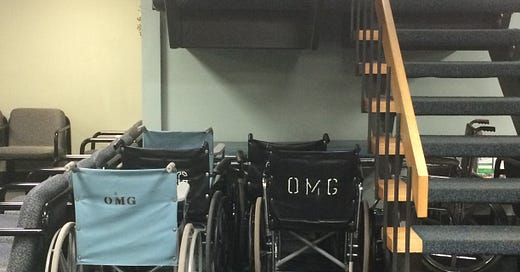




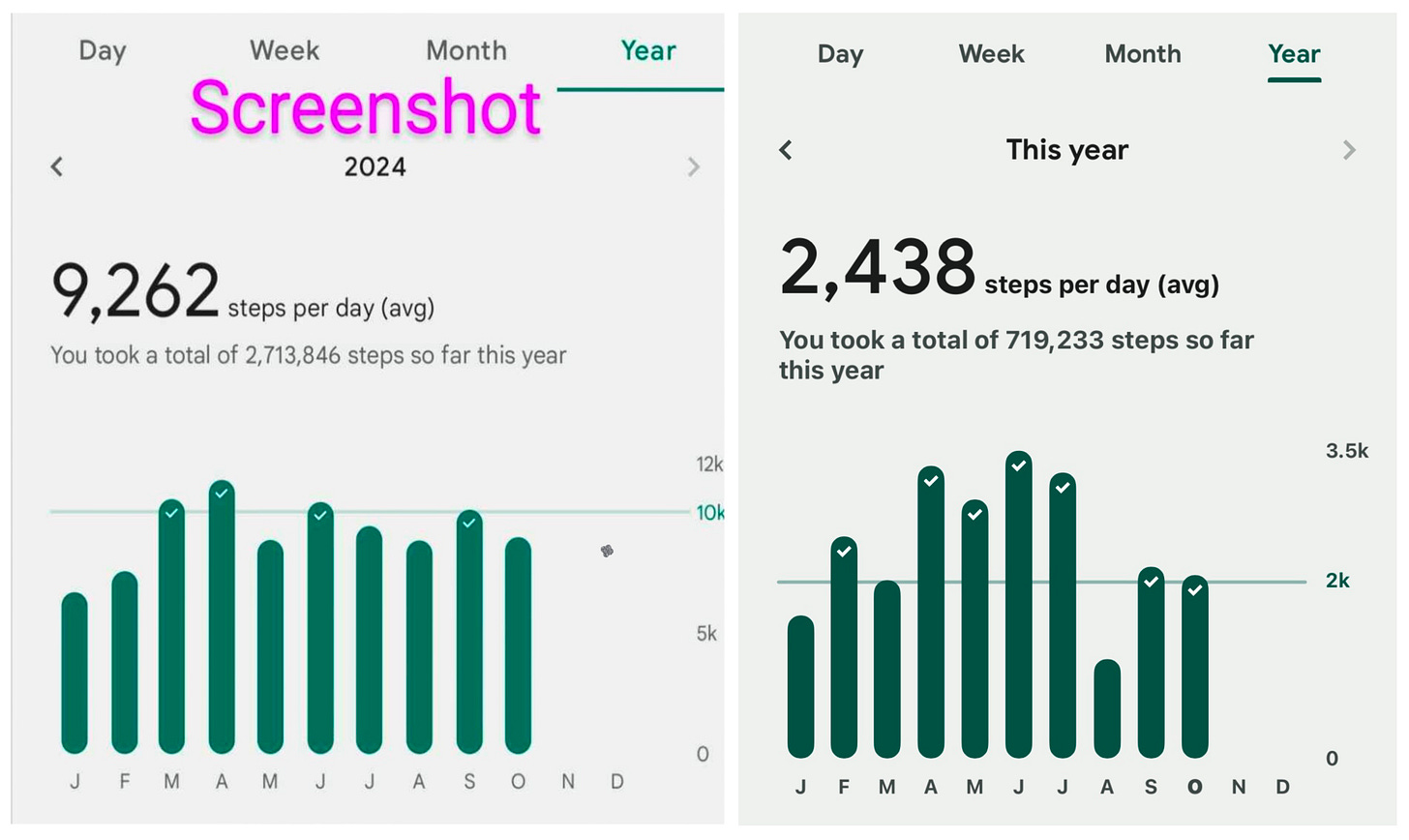
Sending you hugs and love, and hoping for good rest for you!!
GIving you hugs!! I just sent you a text, but I am here to help in any way possible. I truly enjoy your writing style and look forward to more posts.